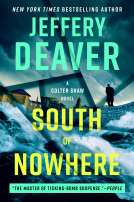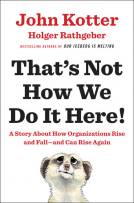
The Signals Are Talking
Why Todays Fringe Is Tomorrows Mainstream
by Amy Webb
This title was previously available on NetGalley and is now archived.
Send NetGalley books directly to your Kindle or Kindle app
1
To read on a Kindle or Kindle app, please add kindle@netgalley.com as an approved email address to receive files in your Amazon account. Click here for step-by-step instructions.
2
Also find your Kindle email address within your Amazon account, and enter it here.
Pub Date Dec 06 2016 | Archive Date May 21 2019
Perseus Books Group, PublicAffairs Books | PublicAffairs
Description
In The Signals are Talking: Why Today’s Fringe is Tomorrow’s Mainstream, Amy Webb shows you how to avoid having to ask that frightening question. Successful business leaders seem to have a sixth sense about what's next; an uncanny ability to predict the next big trend or market development. But it's not magic. Webb teaches you how to spot today the signs of tomorrow's trends; specifically, the trends affecting your world—your market, your products, and your competitors. She demonstrates how the future doesn’t arrive fully formed, but rather emerges step-by-step, appearing first around the fringes of society. But that future is easy to miss unless you know where and how to look.
Books about the near-future, not to mention countless blogs, postings, seminars, and conferences, simply tell you what the author thinks is coming, leaving you to pick the prognostication you prefer. Amy Webb shows you where and how to look in the present for harbingers of the future. Her book is an invaluable resource for leaders of all kinds.
Available Editions
| EDITION | Hardcover |
| ISBN | 9781610396660 |
| PRICE | ₹1,215.00 (INR) |
Average rating from 4 members
Featured Reviews
 Monnie R, Reviewer
Monnie R, Reviewer
Consider me mind-boggled!
But it's not for the first time. That happened somewhere around 1970, when I tried to wrap my head around Alvin Toffler's "Future Shock" (followed by "The Third Wave" and "Power Shift." Then came books by John Naisbitt, such as "Megatrends 2000," and Faith Popcorn's "Clicking: 17 Trends That Drive Your Business And Your Life." Yes, folks, I eat this stuff up. And now, thanks to an advance copy in exchange for an honest review, comes this one - and it's made no less of an impression.
The author has developed a six-part process for forecasting - a way of evaluating new ideas being developed on the "fringe" (a.k.a. around the edges of society) that stand to affect us. Futurists, she says, listen to and interpret the signals that are "talking," looking for early patterns, or pre-trends. "Trends help us to understand change, which is an essential part of every organization's mandate," she writes. "Too often, leaders ignore the signals, wait too long to take action, or plan for only one scenario."
Descriptors like "probable," "plausible" and "possible" are used to generate concrete ideas about what's over the horizon. "We must think of trends as signposts that can illuminate the conditions we will likely encounter at some point in the future, even if that future is a century away," the author explains. "Organizations must track them if they are to create their preferred futures...seeing trends is a matter of looking for emerging changes at the fringe, within organizations, and in our societies."
In a nutshell, if it's possible to put it there, the book is about the importance of not being surprised by the future, offering a method for creating a path that leads to sustained success. Unlike some of the books mentioned above, it's not a list of what we can expect to happen in the next 10, 20 or 50 years; rather, it's a way to help ensure that organizations will be going strong throughout all those years to come.
Along the way, the author explains finer points such as the difference between something that's "trendy" and a "trend." No doubt it's a silly analogy, but if I interpret it anywhere near correctly, an Erector set is (or was) trendy, but the fact that children love to tear things down and build them up again is a trend that's likely to continue indefinitely. Harness your company's future to the first, and you may be out of business the minute a newer kid hits the building block; on the second, and you're likely to stay ahead of the curve.
Roadblocks to identifying the signals are discussed as well, such as the "duality dilemma" between left- and right-brain thinking (put another way, creativity vs. logic) and the need to look at things from both sides now. This I understand; I identify far more closely with the logic side, which most likely explains why I've enjoyed relative success as a journalist (just the facts, ma'am) but couldn't write a novel if my life depended on it. It's also, I'm thinking, one of the reasons I enjoyed this book so much; everything is laid out in an orderly, easy-to-understand manner.
That includes, for the record, a glossary of concepts and terms and a chapter-by-chapter list of footnoted references at the end. Highly recommended for anyone interested in expanding leadership skills (or like me, simply interested in the topic).
Readers who liked this book also liked:
Pamela Samuels Young; Dwayne Alexander Smith
Multicultural Interest, Mystery & Thrillers, Romance
John Kotter; Holger Rathgeber
Business, Leadership, Finance, Nonfiction (Adult)















